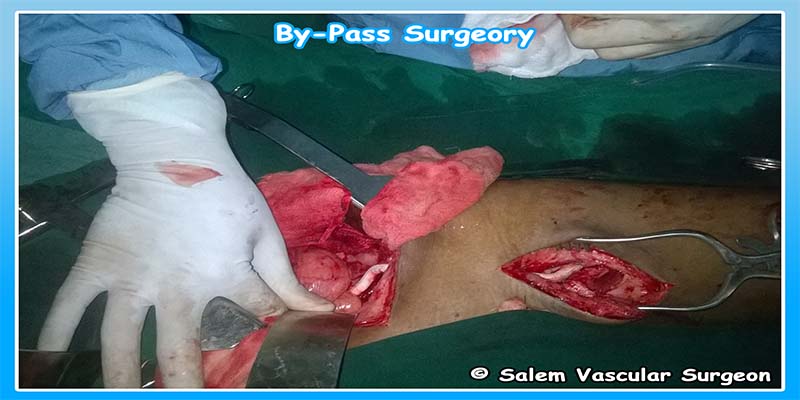Salem Vascular Surgeon
Hospital Address: |
Appointment Time: |
|
VH Speciality Hospital No.11, Dr NV Sundaram Gardens, Brindavan Road, Salem - 636004 |
Monday - Saturday Sunday - Holiday 9 AM - 7 PM |

Bypass Vascular Surgery
A vascular bypass (or vascular graft) is a surgical procedure performed to redirect blood flow in a region of the body. It is commonly performed due to inadequate blood flow (ischemia) and as a part of organ transplantation.
In general, someone's own vein is the preferred graft material (or conduit) for a vascular bypass, but other materials such as ePTFE, dacron or a different person's vein (allograft) are also commonly used.
Arteries can also be redirected and serve as vascular grafts. A surgeon sews the graft to the target vessel by hand using surgical suture, creating a surgical anastomosis.
Risks and complications
A number of complications can arise after vascular bypass.
Risks related to bypass
Acute Graft Occlusion is the occlusion (blockage) of a vascular bypass graft shortly after the bypass is performed. Its causes, which are distinct from those of chronic graft occlusion, include technical failure (e.g. anastomotic stricture, incomplete valve lysis in non-reversed vein) and thrombosis. It is rare, but almost always requires reoperation.
Risks related to surgery
Common bypass sites include the heart (Coronary artery bypass surgery), and the lower extremities, where vascular bypass is used to treat peripheral vascular disease.
Description
You will be given a general or spinal anesthetic so that you will feel no pain during the operation. If needed, you will be given a blood transfusion.
For an aortic bypass, a synthetic graft made of fabric (Dacron) or plastic (PTFE, Gortex) is used, and a vertical midline abdominal incision is made. Surgery can take 3–4 hours.
Recovery
Immediately following vascular bypass surgery, patients recover first in the intensive care unit or Coronary care unit for one to two days. Provided that patients recover normally and without complications, then are then allowed to move to a less intensively monitored unit such as a step-down unit or a ward bed. Monitoring immediately after all types of bypass surgery focuses on signs and symptoms of bleeding. If bleeding is detected, treatment can range from transfusion to reoperation. Later on in the hospital course, common complications include wound infections, pneumonia, urinary tract infection and acute graft occlusion.
At discharge, patients are prescribed oral painkillers, and should be prescribed a statin and an anti-platelet medication if their bypass was performed for atherosclerosis (PVD or CAD as tolerated. Some patients start feeling normal after one month, while others may still experience problems up to six months after the procedure.
During the first twelve weeks after the procedure patients are advised to avoid heavy lifting, hose work as well as strenuous recreation like golf, tennis, or swimming while surgical wounds (particularly the sternum after coronary bypass) heal.
Part of the recovery after any bypass surgery includes regular visits to a physician to monitor the patient's recovery. Normally a follow up visit with a surgeon is scheduled for two to four weeks after surgery. The frequency of these visits gradually lessens as the patient's health improves.
For vascular bypass operations performed for atherosclerosis (PVD and CAS), the operation does not cure the underlying disease. Instead, lifestyle changes that include quitting smoking, making diet changes, getting regular exercise, and lowering stress improve the underlying condition.
Risks
The bypass graft can become blocked soon after surgery or years later. This is sometimes remedied by another surgery or catheter procedure, sometimes by a new bypass.
Other possible complications soon after surgery include:
Copyright © 2025 - All Rights Reserved - Salem Vascular Surgeon | Designed & Developed By Dazz IT Wing